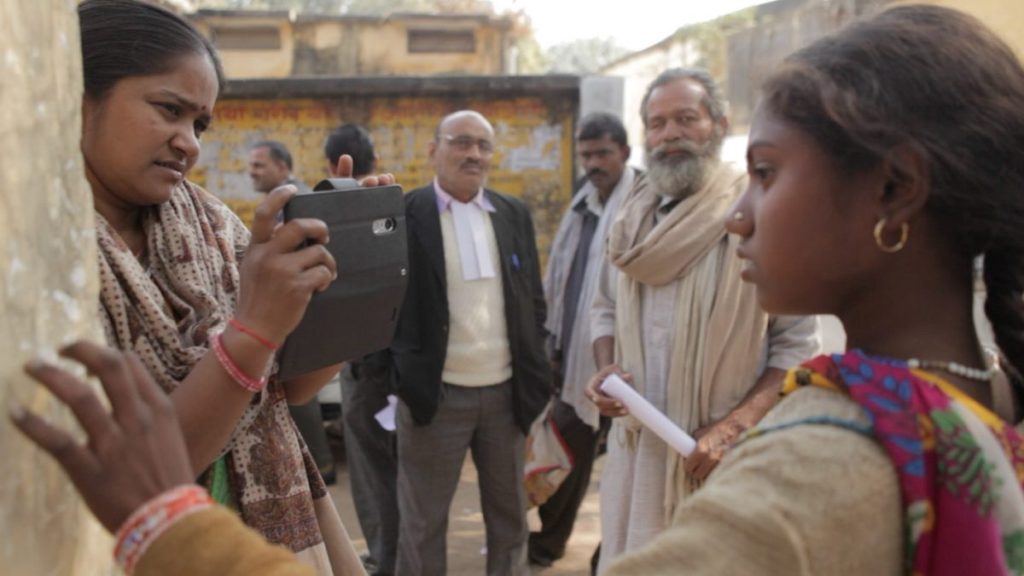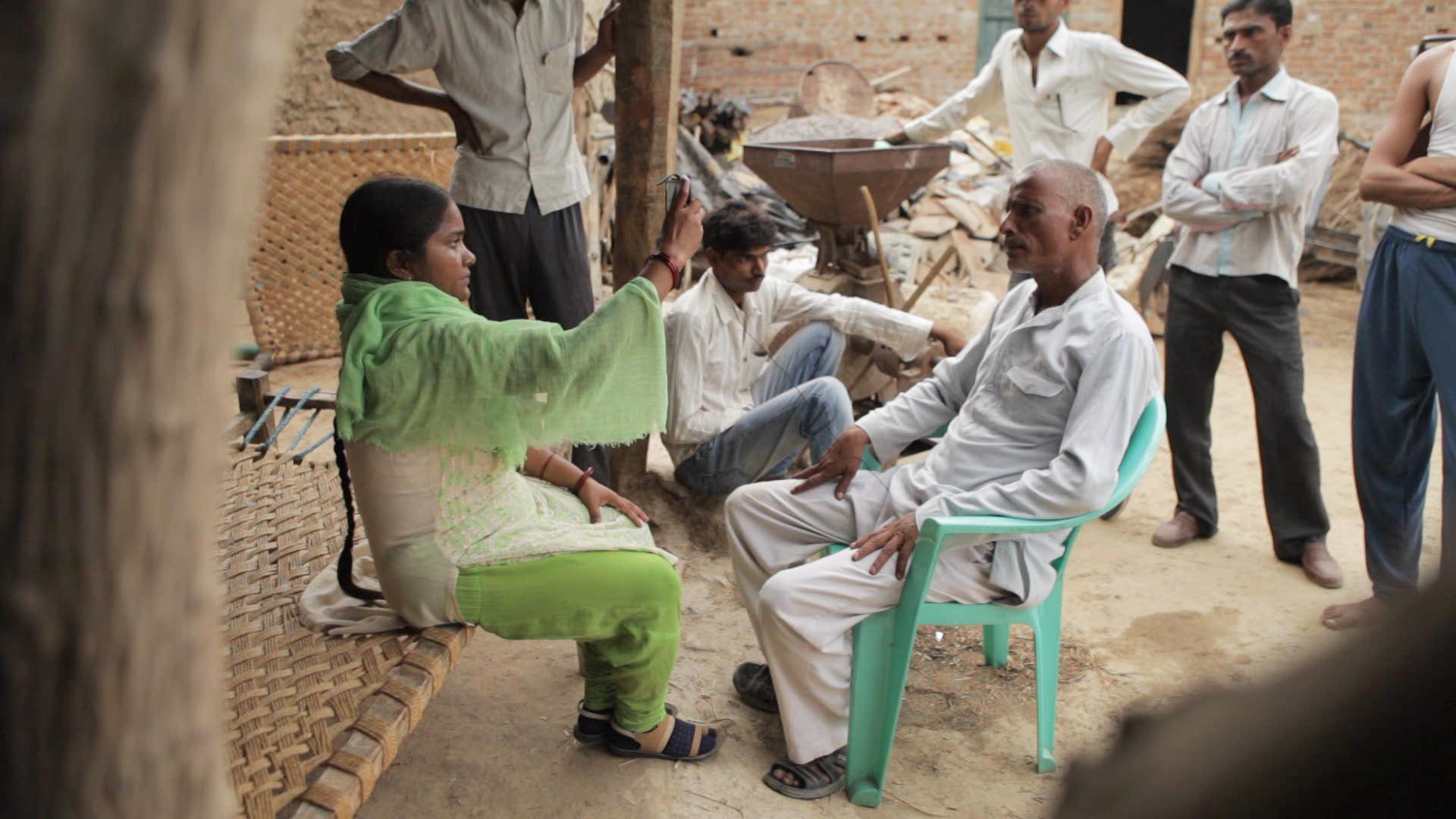
“Writing with Fire” is an Indian documentary of citizen journalism at its most elemental and vital.
It’s about Khabar Lahariya, the Northern Indian activist newspaper wholly staffed by “lower-caste” women who teach each other the journalism basics and then go out among the people, politicians and police and confront the neighborhood’s, region’s and culture’s most pressing issues with hard-hitting stories aimed at instigating change.
It’s what all journalism is supposed to be and once was — grassroots. And the women of Khabar Lahariya, “Waves of News,” practice it with a passion that’s inspiring and in ways that would make much Western mainstream media blush in shame.
In a patriarchal country where “rape culture” is a national tragedy shrugged off by men at every level of power, these women — some educated, others trained on the job — doggedly question India’s do-nothing because “Nothing can be done” police and politicians and ask questions at press conferences that have their male press counterparts patronizingly scold them for their impertinence.
Indian filmmakers Rintu Thomas and Sushmit Ghosh (“Dilli,” “Timbuktu”) take us into the staff meetings and training sessions of this Uttar Pradesh (northern India) enterprise, and then follow some of the star journalists of the paper as it transitions into a digital media enterprise, gathering news far and wide via cell phones.
Meera Davi is the top reporter there, and we see her example spreading among the other staff. She is, she tells us, “Dalit,” lower-caste in a culture where the accident of birth is still everything. But Meera is, we learn, educated and had several jobs that used that education before.
Stepping into journalism, which she describes as “an upper caste profession,” she found her place in the world and started making her mark.
The camera crew follows her and fellow journalists Suneeta Prajapati and Shyamkali Devi as they interview rape victims, one of whom tells of repeated assaults by a local gang — “These men can do anything,” she complains. She is taking a terrible risk even speaking out.
“I am giving you this interview now. Who knows what will happen to us tonight?”
Then we follow the reporter to the police station, where the smirking, sunglasses-indoors Indian police of legend and international stereotype face their first-ever journalistic reckoning.
“Why was no report filed? Why have you done nothing?” wipes the smirks away with persistence and steady exposure via the spotlight of media attention.
This “afflict the comfortable, comfort the afflicted” ethos and “Why is nothing being done?” advocacy is applied to every story they report — illegal “mafia” gravel pit mines where child labor is employed, workers are injured or killed and villages swallowed up, helpless because the local authorities look the other way. Another village is decimated by a tuberculosis outbreak until reporting shames the government into action.
Violence against journalists in that part of the world is touched on, every so often, and emphasized with graphics.
As these women courageously step into situations, we wonder about their safety and if the size of the documentary camera crew following them might protect them. There’s always a mouthy local man emboldened by the local men around him into insulting the reporter, a woman alone, telling her to “know your place” or some variation.
What’s startling is seeing that behavior in press conferences where Meera, Suneeta and others politely ask blunt, hard-hitting questions and are chided by a scrum of media men who suggest emphasizing “the positive,” complimenting these political hacks, sexist, lazy public servants and openly corrupt louts.
One even takes his “mansplaining” to the street afterward, lecturing a Suneeta (in Hindi, with English subtitles) in what’s “simply not done” in such public press events.
A politician dismisses “rapes” as “mistakes made by silly boys” and describe rape as “a mental health issue,” code-language for “Do nothing about rape/poverty/guns” the world over. He is taken aback when there are follow-up questions.
The film’s third act shows the daunting task of facing the thuggish, racist conservatism of Narendra Modi and his ruling BJP Party at the local level — politicians and local leaders exposed as advocating violence, and the “protect our (literally) sacred cows” distractions the party’s backers fall for, take to the streets and riot over.
Meanwhile, the protestors have no indoor plumbing at home and bleak lives with limited futures, all a product of their gullible political choices and the cynical oligarchs who lead them.
And through all this, Khabar Lahariya “goes digital,” with its reporters not only learning and teaching each other the basics — just enough English to be able to use a cell phone, which many of them have never had access to, how to gather cover-footage, video inserts and the like.
The reporters find themselves patiently explaining video journalism to local politicians, who wonder why they’re videoing their entourages, getting shots of their homes and the like. The reporters listen to “send me your story before publishing” demands that they’ve learned to ignore, even if the American term “prior restraint” isn’t something they’ve heard or feel the need to explain to bullying officials.
Meera clucks at “self-styled religious gurus” who “exploit people,” and lectures her fellow reporters to ensure that they don’t simply uncritically amplify unsupported claims of such political-religious charlatans, but fact-check, dispute and confront them.
Wonder if she’s available for DC Press Corps workshops?


We see the skyrocketing impact of the newspaper’s new digital reach, its Youtube channel’s exploding popularity, the women doing “promos” familiar to any local TV station viewer, where the journalists herald their triumphs at “bringing change” to a ruined road long-ignored, epidemics responded to and the like.
Filmmakers Ghosh and Thomas give us a glimpse of the women’s home lives, the supportive (and not so supportive) spouses, the pressure from families to “not bring shame” on their Dalit lower caste status, as if either concept is anything but ludicrous.
We don’t get any notion of the newspaper’s business model, the way it pays its bills through the digital transition (a Youtube channel and a lean staff are but a good start). We only glimpse the training, and see none of the stumbling efforts to learn to be at ease doing TV stand ups, walking and talking reports and the film.
The film makes such “digital transition” stumbling blocks look as effortless as taking your first selfie. Having worked at newspapers going through that “change,” I can tell you, it’s not.
And for all the emphasis on “rape culture,” we never ever see a rapist brought to justice thanks to their efforts.
But “Writing with Fire” still a shock-to-the-system reminder that, as Meera says, “Journalism is the essence of democracy,” how “the People” get “justice in a democracy.” It’s not about click-baiting the most reliable if ignorant and “wrong” audience, trolling and “both-siding” issues as fundamental as the human rights, voting rights, right and wrong and the rule of law.
Let’s hope it “inspires” those who really need to see it.
Rating: unrated, discussions of violence, rape
Cast: Meera Devi, Suneeta Prajapati and Shyamkali Devi
Credits: Directed by Sushmit Ghosh and Rintu Thomas. A Music Box release.
Running time: 1:32

